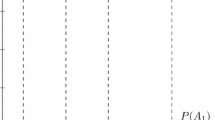Abstract
An agent often has a number of hypotheses, and must choose among them based on observations, or outcomes of experiments. Each of these observations can be viewed as providing evidence for or against various hypotheses. All the attempts to formalize this intuition up to now have assumed that associated with each hypothesis h there is a likelihood function μ h , which is a probability measure that intuitively describes how likely each observation is, conditional on h being the correct hypothesis. We consider an extension of this framework where there is uncertainty as to which of a number of likelihood functions is appropriate, and discuss how one formal approach to defining evidence, which views evidence as a function from priors to posteriors, can be generalized to accommodate this uncertainty.
Similar content being viewed by others
References
Epstein, L., & Schneider, M. (2007). Learning under ambiguity. Review of Economic Studies, 74(4), 1275–1303.
Good, I. J. (1950). Probability and the weighing of evidence. London: Charles Griffin & Co. Ltd.
Halpern, J. Y. (2003). Reasoning about uncertainty. Cambridge: MIT Press.
Halpern, J. Y., & Fagin, R. (1992). Two views of belief: Belief as generalized probability and belief as evidence. Artificial Intelligence, 54, 275–317.
Halpern, J. Y., & Pucella, R. (2005). Probabilistic algorithmic knowledge. Logical Methods in Computer Science, 1(3:1), 1–26.
Halpern, J. Y., & Pucella, R. (2006). A logic for reasoning about evidence. Journal of Artificial Intelligence Research, 26, 1–34.
Kyburg, H. E., Jr. (1983). Recent work in inductive logic. In T. Machan & K. Lucey (Eds.), Recent work in philosophy (pp. 87–150). Lanhan: Rowman & Allanheld.
Shafer, G. (1976). A mathematical theory of evidence. Princeton: Princeton University Press.
Shafer, G. (1982). Belief functions and parametric models (with commentary). Journal of the Royal Statistical Society, Series B, 44, 322–352.
Author information
Authors and Affiliations
Corresponding author
Additional information
A preliminary version of this paper appeared in the Proceedings of the 21st Conference on Uncertainty in Artificial Intelligence, pp. 243–250, 2005. Most of this work was done while the second author was at Cornell University.
Rights and permissions
About this article
Cite this article
Halpern, J.Y., Pucella, R. Evidence with uncertain likelihoods. Synthese 171, 111–133 (2009). https://doi.org/10.1007/s11229-008-9381-z
Received:
Accepted:
Published:
Issue Date:
DOI: https://doi.org/10.1007/s11229-008-9381-z



